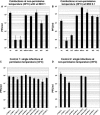Genome replication and progeny virion production of herpes simplex virus type 1 mutants with temperature-sensitive lesions in the origin-binding protein
- PMID: 15890967
- PMCID: PMC1112152
- DOI: 10.1128/JVI.79.11.7273-7278.2005
Genome replication and progeny virion production of herpes simplex virus type 1 mutants with temperature-sensitive lesions in the origin-binding protein
Abstract
Genome replication of herpes simplex viruses (HSV) in cultured cells is thought to be started by the action of the virus-encoded origin-binding protein (OBP). In experiments using two HSV-1 mutants with temperature-sensitive lesions in the helicase domain of OBP, we demonstrated that this function is essential during the first 6 hours of the lytic cycle. Once DNA synthesis has started, this function is no longer required, suggesting that origin-driven initiation of viral DNA replication is a single event rather than a continuous process.
Figures




Similar articles
-
The DNA binding domain of herpes simplex virus type 1 origin binding protein is a transdominant inhibitor of virus replication.Virology. 1993 Mar;193(1):73-9. doi: 10.1006/viro.1993.1104. Virology. 1993. PMID: 8382413
-
Existence of transdominant and potentiating mutants of UL9, the herpes simplex virus type 1 origin-binding protein, suggests that levels of UL9 protein may be regulated during infection.J Virol. 2003 Sep;77(17):9639-51. doi: 10.1128/jvi.77.17.9639-9651.2003. J Virol. 2003. PMID: 12915576 Free PMC article.
-
Origin binding protein-containing protein-DNA complex formation at herpes simplex virus type 1 oriS: role in oriS-dependent DNA replication.J Virol. 2001 Aug;75(15):6808-16. doi: 10.1128/JVI.75.15.6808-6816.2001. J Virol. 2001. PMID: 11435559 Free PMC article.
-
HSV-1 DNA Replication-Coordinated Regulation by Viral and Cellular Factors.Viruses. 2021 Oct 7;13(10):2015. doi: 10.3390/v13102015. Viruses. 2021. PMID: 34696446 Free PMC article. Review.
-
Herpes simplex virus DNA replication.Annu Rev Biochem. 1997;66:347-84. doi: 10.1146/annurev.biochem.66.1.347. Annu Rev Biochem. 1997. PMID: 9242911 Review.
Cited by
-
DNA binding activity of the herpes simplex virus type 1 origin binding protein, UL9, can be modulated by sequences in the N terminus: correlation between transdominance and DNA binding.J Virol. 2006 May;80(9):4491-500. doi: 10.1128/JVI.80.9.4491-4500.2006. J Virol. 2006. PMID: 16611909 Free PMC article.
-
Herpes simplex virus type 1 C-terminal variants of the origin binding protein (OBP), OBPC-1 and OBPC-2, cooperatively regulate viral DNA levels in vitro, and OBPC-2 affects mortality in mice.J Virol. 2007 Oct;81(19):10699-711. doi: 10.1128/JVI.01213-07. Epub 2007 Jul 18. J Virol. 2007. PMID: 17634223 Free PMC article.
-
Respiratory infections by HMPV and RSV are clinically indistinguishable but induce different host response in aged individuals.PLoS One. 2011 Jan 26;6(1):e16314. doi: 10.1371/journal.pone.0016314. PLoS One. 2011. PMID: 21298115 Free PMC article.
-
Direct interaction between the N- and C-terminal portions of the herpes simplex virus type 1 origin binding protein UL9 implies the formation of a head-to-tail dimer.J Virol. 2007 Dec;81(24):13659-67. doi: 10.1128/JVI.01204-07. Epub 2007 Oct 17. J Virol. 2007. PMID: 17942532 Free PMC article.
-
The DNA helicase-primase complex as a target for herpes viral infection.Expert Opin Ther Targets. 2013 Oct;17(10):1119-32. doi: 10.1517/14728222.2013.827663. Epub 2013 Aug 12. Expert Opin Ther Targets. 2013. PMID: 23930666 Free PMC article. Review.
References
-
- Aslani, A., M. Olsson, and P. Elias. 2002. ATP-dependent unwinding of a minimal origin of DNA replication by the origin binding protein and the single-strand DNA binding protein ICP8 from herpes simplex virus type 1. J. Biol. Chem. 25:41204-41212. - PubMed
-
- Blümel, J., and B. Matz. 1995. Thermosensitive UL9 gene function is required for early stages of herpes simplex virus type 1 DNA synthesis. J. Gen. Virol. 76:3119-3124. - PubMed
-
- Boehmer, P. E., and I. R. Lehman. 1997. Herpes simplex virus DNA replication. Annu. Rev. Biochem. 66:347-384. - PubMed
Publication types
MeSH terms
Substances
LinkOut - more resources
Full Text Sources

